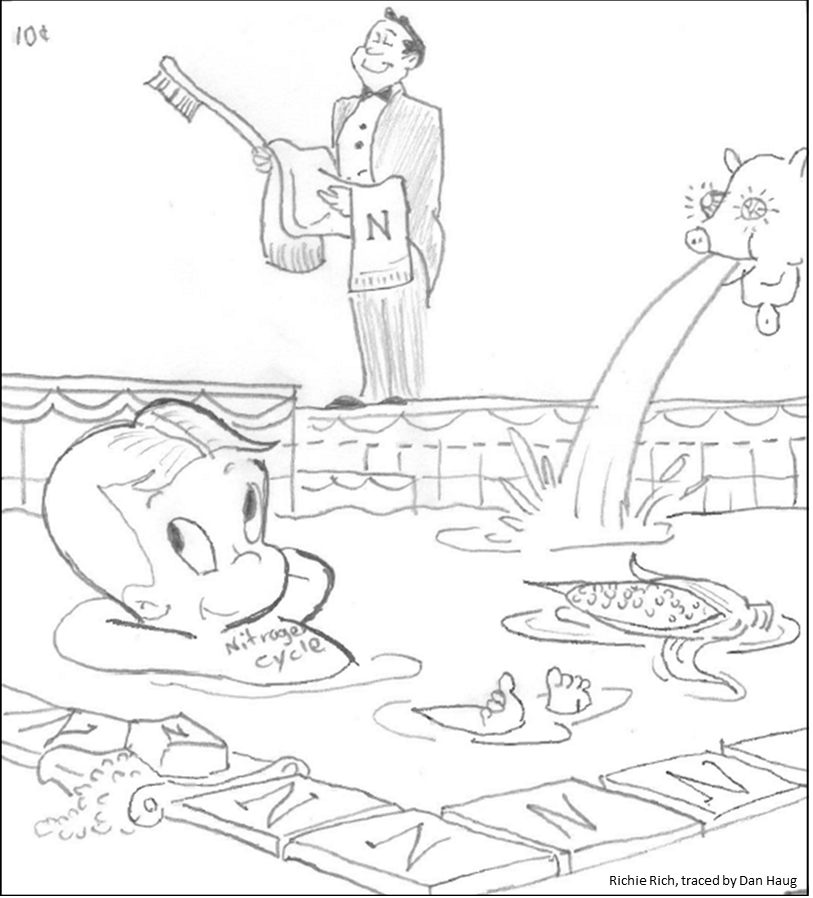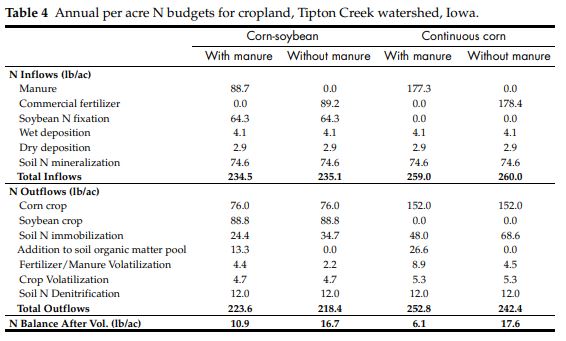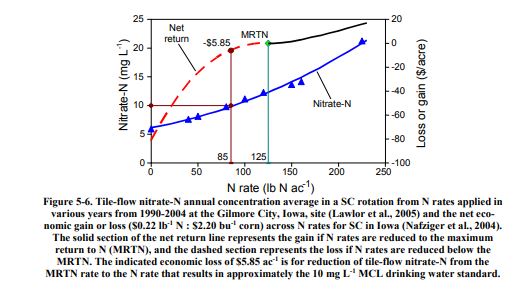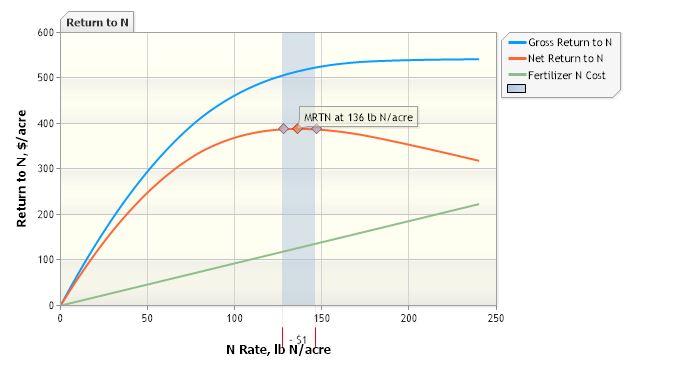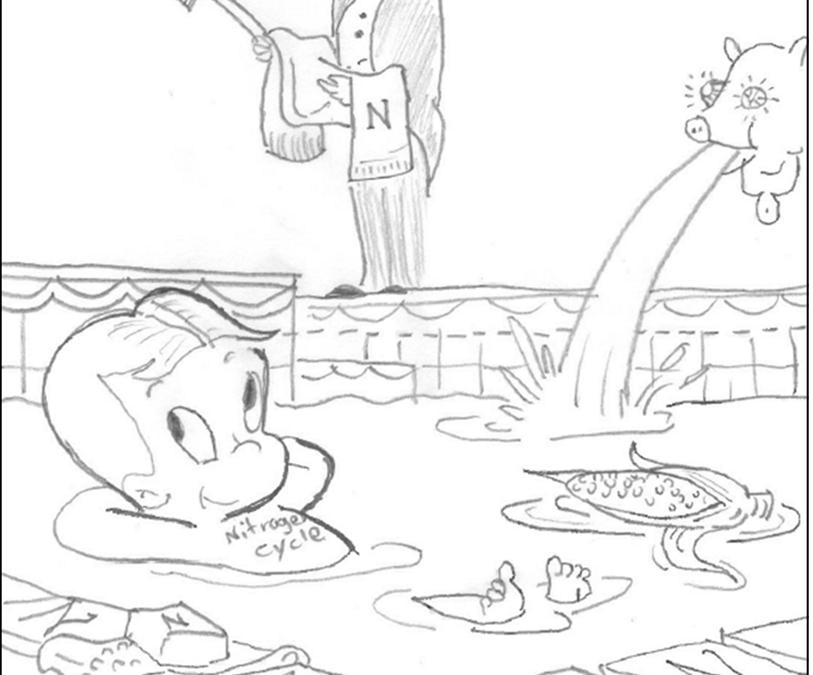
by Dan Haug | Jun 26, 2022
Imagine the nitrogen cycle is a trust fund kid with a gambling problem.
The young man (a corn field) is very rich (has rich black soil) but the money (nitrogen) he inherited from his father (the prairie) is locked in a trust fund (soil organic matter). Only a small portion of the funds are released to him each year (mineralized) following a complicated schedule determined by the trustees (microbes in the soil). In order to maintain the lifestyle to which he has become accustomed (provide enough nitrogen to the crop for good yields), he needs supplemental income (nitrogen from commercial fertilizer or manure). His sister (a soybean field) does not need to work (apply fertilizer) because she can borrow money from her well-connected husband (symbiotic nitrogen-fixing bacteria) but she also receives payments from the trust (mineralization). She helps her brother out (corn needs less nitrogen fertilizer following soybeans) but not directly (soybeans actually use more nitrogen than they fix, so the benefits of the rotation has more to do with the behavior of the residue and disrupting corn pests).
Both siblings have a gambling (water quality) problem and are terrible poker players. Whenever they’re feeling flush with cash (when other forms of nitrogen have been converted to nitrate) they blow some of it playing cards (nitrate easily leaches out of the root zone when it rains), but the extent of the losses vary and debts aren’t always collected right away (nitrate leached out of the root zone may not immediately reach streams). They struggle with temptation more than their cousins (alfalfa and small grains) because they come from a broken home (the soil is fallow for large parts of the year) and because bills and income don’t arrive at the same time (there is a mismatch between the timing of maximum nitrogen and water availability and crop nitrogen and water use).
“”Okay, Dan, that’s very clever, but what’s your point?
Well, having compared the soil to a trust fund, I can now say “don’t confuse net worth with income.” You’ve probably heard that there 10,000 pounds per acre of nitrogen stored in a rich Iowa soil. That’s true but misleading. The amount actually released each year by decomposing organic matter (net mineralization) is only a few percent of that, comparable in size and importance to fertilizer or manure. Here’s an example nitrogen budget.
On average and over the long-term, we know that fields and watersheds with higher nitrogen applications (taking into account both manure and commercial fertilizer) leach more nitrate into the water. On average and over the long-term, we know that that farmers can profit by reducing their application rate to the Maximum Return To Nitrogen (the point at which another pound of nitrogen does not produce a big enough yield bump to offset the fertilizer costs). Right now, with corn prices high but fertilizer prices going nuts, the MRTN is 136 pounds per acre for corn following soybeans, while in the most recent survey I could find, farmers reported applying an average of 172 pounds per acre. So there’s room to save money while improving water quality!
But having compared nitrate leaching to gambling, I can also say “don’t confuse a balance sheet problem with a cash flow problem.” In any given year, it’s always a gamble how much of the nitrogen that’s applied will be washed away and how much will be available to the crop. Maybe some farmers are passing up on an opportunity to increase their profits because they’re not comfortable with the short-term risks.
Farmers say that extra nitrogen is cheap insurance. If that’s true, maybe we need crop insurance that makes it easier to do the right thing, not a more precise calculator.
by Dan Haug | Oct 9, 2019
Nitrogen rate management (MRTN) is the low-hanging fruit of the Iowa Nutrient Reduction Strategy, a win-win for profitability and the environment. On closer inspection, that fruit is even juicier than we thought; but harder to reach.
Here’s the paradox of nutrient management that the general public fails to grasp. We don’t know with any certainty at application time how much nitrogen the corn crop will need or how much nitrogen will be left in the soil come July when the crop starts maturing. Corn stalk nitrogen tests and split applications can improve the accuracy of the guess, but farmers still have to guess. If they guess too low, they lose income. So most farmers err on the high side, which means that (all else being equal) more nitrogen will end up in our streams.

Figure by John Sawyer at ISU. The economically optimum nitrogen rate varies by year, even on the same field.
We may not know what’s the right amount of nitrogen to apply this year, but we can pinpoint a range that makes the most economic sense across sites and years. In 2005, Iowa State University researchers crunched the numbers and developed an online calculator. A farmer can enter current prices for corn and fertilizer to get the Maximum Return To Nitrogen (MRTN). Above that range, they might get a bit higher yield, but the revenue from those extra bushels doesn’t offset the cost of the extra nitrogen. Applying nitrogen at the MRTN is a rare win-win for profitability and the environment.
Along with cover crops, wetlands, and bioreactors, MRTN was one of the more promising practices for nitrogen outlined in the Iowa Nutrient Reduction Strategy. Still, the authors cautioned that it wouldn’t get us very far by itself. An average field would cut nitrate losses by 10 percent. Since some parts of the state apply less nitrogen than others, universal adoption of this practice would get us a 9 percent reduction in nitrate concentrations.

That modest reduction assumes Iowa farmers currently apply 150 lbs of N/acre on a corn-bean rotation and 190 lbs/acre on continuous corn, a figure the authors admitted were “possibly outdated.” A 2017 survey by ag retailers found that Iowa farmers apply 169 lbs/acre of nitrogen on corn after beans and apply 210 lbs N/acre on continuous corn. I updated Dr. Helmers graph with those numbers and an MRTN based on current corn and nitrogen prices to determine the potential water quality benefit. This low-hanging fruit is juicier than we thought!

And that’s just the average! Inspired by a recent essay by Chris Jones, I read a manure management plan for a field in one of our watersheds. It receives 190 lbs/acre of nitrogen and 146 lbs/acre of phosphorus in the form of liquid swine manure. If that manure could be spread over more acres at a rate of 140 lbs/acre, that could reduce nitrate losses by 31%. If it replaces rather than supplements commercial fertilizer, we could get another 4% cut in nitrate. Manure is a slow-release fertilizer and less susceptible to leaching.

Is that economical? Hard to say. Daniel Anderson reports that liquid swine manure can be moved seven miles and still be cheaper than synthetic fertilizer. In Story and Boone County that might work. Hamilton County has 218 manure management plans, so I’m not sure how far you’d need to travel to find a field not already being treated. Are there changes in processing or additional cost share that would help make it more feasible? I don’t know. No-one is talking about it. But cover crops work equally well. Winter rye grows thicker with fall-applied manure and can scavenge nitrogen that would otherwise be lost.
Unfortunately, neither of those options (MRTN or cover crops) are even suggested as part of manure management plans and the loudest voices in the room are saying livestock producers don’t need to be doing anything differently. Until that situation changes, the widespread adoption of rate management that’s assumed in statewide and watershed-based scenarios won’t happen and we will fail to meet our nutrient reduction goals.


